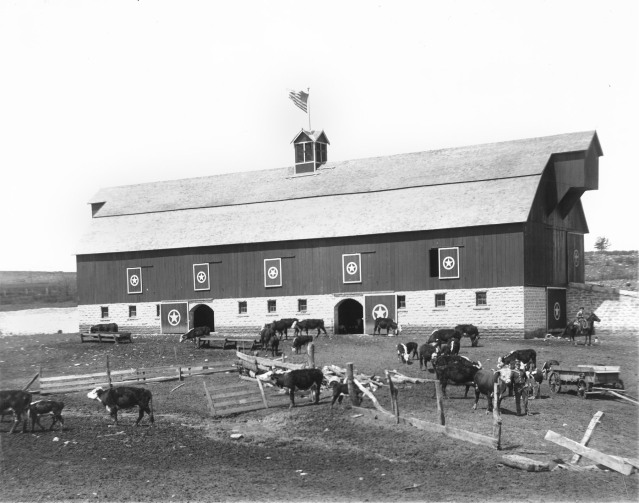
The Henry Sump barn, seen here, was constructed of solid walnut, cut on the site, along with native limestone quarried locally. Sump was struck by lightning and died at his ranch in 1920 while operating a manure spreader.
Wabaunsee County enjoys a rich ranching heritage which is reflected in the many expansive barns which adorned the landscape. All of late 19th century and early 20th century barns had large hay lofts to accommodate the storage of loose hay. Later, the loft provided storage for small bales of hay.
Barns which had cupolas attached to the top signify buildings where stock were kept in the basements. The cupola allowed water vapor created by livestock’s breath to escape the barn.

This Charles Herman color slide of the Schepp Barn was taken in the 1970s.
By the 1980 there were no more barns being constructed which contained hay lofts, as haying operations had almost exclusively moved to large round bales which could be stored in pole barns or simply stacked in the weather.
Another changing feature of Flint Hills barns was the evolution to metal buildings for barn siding and construction. After 1980 there were virtually no barns constructed of wood, and absolutely none constructed of stone in Wabaunsee County.
Click on any image below to view all images in a gallery format.

The William Mitchell barn, photographed here by Charles Herman in the 1970s, is located just east of Wabaunsee, Kansas.

The Wiser barn suffered from a failing roof, and storm winds demolished the iconic barn in the early 2000’s. Photo by Michael Stubbs.

J.P. Wiser’s expansive cattle ranch, located in southern Wabaunsee County was managed by Wiser’s son, Harlow Wiser. In this view, from around 1900, a team of railroad surveyors are visible in the foreground. Notice that the windmill which sat atop the barn had been removed by this time. Photo Courtesy Ellen Coffman.

Construction on the Wiser barn was completed in 1884 and a grand opening dinner and barn dance was held on October 30, 1884 to celebrate its completion. Photo courtesy Ellen Coffman.

This interior view of the hay loft in the Peter Thoes barn was taken in the early 1980s, before the far end of the barn deteriorated and was removed. Photo by Greg Hoots.

This view of the Peter Thoes barn was taken in the early 1980s before the far end of the barn suffered a collapse and was removed. Photo by Greg Hoots.

The Henry Sump barn, seen here, was constructed of solid walnut, cut on the site, along with native limestone quarried locally. Sump was struck by lightning and died at his ranch in 1920 while operating a manure spreader.

Henry Sump, stands in the foreground with his barn visible in the background. Sump had the barn built in 1905.

This Charles Herman color slide of the Schepp Barn was taken in the 1970s.

This view of the Schepp barn was taken in 1921.

The Schepp barn was constructed by Alma stonemason, August Falk. This view was taken shortly after the barn was completed in 1905.























THANKS TO EACH OF YOU THAT HAS MADE HISTORY COME TO LIFE. SO WELL DONE. KEN GNADT
LikeLike
GREG, THANKS FOR SHARING. GLEN CZIRR AND I TOURED THE BARN NEARLY 10 YEARS AGO. IT WAS ONE OF THE MOST UNIQUE BARNS I’VE SEEN. THANKS FOR SHARING AND THE WAY TO CLICK INTO BARNS IN WABSUNSEE COUNTY. LOVE BARNS AND WINDMILLS. KEN GNADT
LikeLike